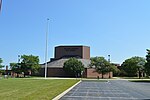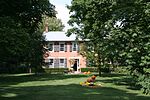Noor Islamic Cultural Center

The Noor Islamic Cultural Center (NICC) is a cultural center and mosque in Columbus, Ohio, USA. The building was started in 2001 and completed in 2006. NICC is the first Islamic center to become a polling place in Central Ohio. It is a center for Muslims. It includes a mosque for prayer purposes, a social hall, kitchen, classrooms, and lecture rooms. It is stated to be "a place for everyone to come, learn, and practice Islam in every element." The center holds five daily prayers in congregation, Islamic lectures, Sunday school for youth, children's club, study groups, and individual lesson and classes to learn the Quran and Sunnah of the Islamic prophet Muhammad. The center also offers outreach programs for non-Muslims who are interested in learning about Islam.
Excerpt from the Wikipedia article Noor Islamic Cultural Center (License: CC BY-SA 3.0, Authors, Images).Noor Islamic Cultural Center
Wilcox Road, Washington Township
Geographical coordinates (GPS) Address Nearby Places Show on map
Geographical coordinates (GPS)
| Latitude | Longitude |
|---|---|
| N 40.065482 ° | E -83.149358 ° |
Address
Wilcox Road 5111
43016 Washington Township
Ohio, United States
Open on Google Maps








